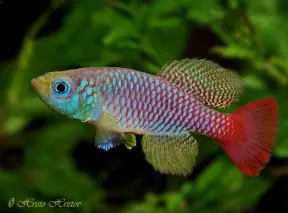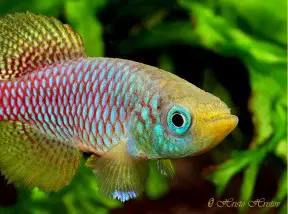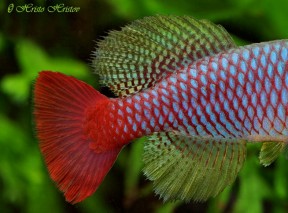Nothobranchius foerschi
Classification
Order: Cyprinodontiformes Family: Nothobranchiidae
Distribution
Described from Soga, a small settlement located west of Dar es Salaam city, eastern Tanzania, and may be restricted to a relatively small area within the Ruvu River catchment, between Soga and the coastal town of Bagamoyo.
In 1891 it was also recorded in the Selous Game reserve, within the Rufiji River watershed, but this information has been called into question since the species has never been found there since and there exists no photographic evidence or preserved material from the Rufiji with all confirmed records pertaining to the Ruvu and its delta.
Habitat
Inhabits ephemeral, water-filled depressions, pools and swamps mostly located in lowland floodplains. Water levels in these seasonally-variable habitats typically decrease during the dry season and eventually become completely dessicated for several months each year.
Near Bagamoyo it’s been collected from pools of a flat, grassy floodplain alongside the congeners N. annectens, N. janpapi and N. melanospilus, while at Soga it occus together with N. janpapi and N. ocellatus. Most habitats appear to be heavily overgrown with terrestrial vegetation.
Maximum Standard Length
Male: 5.5 cm
Female: 4 cm
Aquarium SizeTop ↑
Unless isolated temporarily for spawning purposes even a single pair should be offered an aquarium with base dimensions of 45 ∗ 30 cm or more.
Maintenance
This species does not require peat although peat moss is often used as a spawning medium.
Water Conditions
Temperature: 20 – 24 °C
pH: 6.5 – 7.5
Hardness: 179 – 447 ppm
Diet
A natural micropredator meaning small live or frozen foods such as Daphnia, Artemia and chopped bloodworm should form the basis of the diet.
Sexual Dimorphism
Males grow larger and are far more colourful than females.
Reproduction
When its natural habitats become dessicated during the dry season the adult fish die, leaving fertilised eggs encased within the substrate. These are resistant to dessication and remain there until the rains return some 5-6 months later at which point the fry hatch and grow very quickly with sexual maturity reached at around 3 weeks of age.
Typical lifespan in the aquarium is 12-24 months and eggs should be stored at a temperature of 70-77°F/21.1-25°C for around 3 months before being wetted. Some aquarists add a little marine salt to the water in order to reduce the risk of Oödinium, to which the fry are particularly susceptible.
NotesTop ↑
Wild collections are generally labelled with some form of code in order that they can be told apart, thus limiting the possibility of hybridisation, for example ‘Ruvu River ‘TZ 91-103’ in which ‘TZ’ is ‘Tanzania’, ’91’ the year of collection (1991), and ‘103’ collection locality. There also exists an aquarium strain which appears more yellowish than the wild form.




